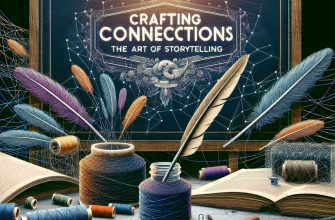Mastering the Art of Storytelling in Marketing: Essential Strategies for Captivating Your Audience
In the digital age, where consumers are bombarded with countless advertisements every day, standing out from the noise requires more than just a catchy slogan or a flashy banner. It demands a return to one of the most ancient and powerful forms of communication: storytelling. As a digital marketing expert, I’ve seen firsthand how brands that master the art of storytelling not only capture but also retain the attention of their audience, forging connections that transcend the transactional. Here, we’ll explore essential strategies for weaving compelling narratives into your marketing efforts.
Understanding the Power of Storytelling
At its core, storytelling is about connection. It’s a bridge between the teller and the listener, a shared experience that can evoke emotions, inspire actions, and foster a sense of community. In marketing, storytelling transforms your message from a mere proposition into an engaging narrative that places your audience at the heart of the story. This approach not only increases the memorability of your message but also enhances the emotional resonance with your brand.
Crafting Your Brand’s Narrative
The first step in mastering storytelling in marketing is to define your brand’s narrative. This narrative should be authentic, reflecting your brand’s values, mission, and vision. It’s not just about what you sell, but why you sell it, and the impact it has on your customers’ lives. Consider your brand’s origin story, the challenges you’ve overcome, and the successes you’ve achieved. These elements provide a rich tapestry from which to craft compelling stories.
Knowing Your Audience
A story is only as effective as its relevance to the audience. Therefore, a deep understanding of your audience is crucial. What are their needs, desires, and pain points? How do they perceive your brand? What kind of stories would resonate with them? Answering these questions can help tailor your narrative to ensure it strikes a chord with your audience. Creating personas can be a useful tool in this process, allowing you to visualize and empathize with your audience as you craft your stories.
Embracing Multiple Storytelling Formats
The digital landscape offers a plethora of platforms and formats for storytelling, from traditional blog posts and articles to videos, podcasts, and social media stories. Each format has its strengths and can cater to different segments of your audience. For instance, video is unparalleled in its ability to convey emotion and showcase product benefits in a dynamic way, while articles and blog posts can provide deeper insights and thought leadership. Leveraging a mix of these formats can help you reach a broader audience and cater to different preferences.
Incorporating Visuals and Emotions
Humans are visual creatures, and emotions drive our decisions. Incorporating visuals into your storytelling can significantly enhance its impact. This could be through captivating images, infographics, or videos that complement your narrative. Similarly, tapping into emotions – whether it’s joy, surprise, empathy, or even sadness – can make your story more memorable and compelling. The key is to ensure that these emotions are authentic and align with your brand’s values.
Engaging Through Interactive Storytelling
Interactive storytelling is a powerful way to engage your audience actively. This can include anything from interactive infographics and quizzes to augmented reality experiences and interactive videos. By involving your audience in the story, you not only increase engagement but also foster a deeper connection with your brand. This approach can be particularly effective in explaining complex products or services, as it allows the audience to explore the information in a fun and engaging way.
Measuring the Impact of Your Stories
As with any marketing strategy, it’s important to measure the impact of your storytelling efforts. This can include tracking engagement metrics such as likes, shares, comments, and view time, as well as more direct business outcomes like lead generation and sales. Analyzing these metrics can provide insights into what stories resonate with your audience and why, allowing you to refine your approach and maximize the impact of your storytelling.
The Art of Storytelling in Marketing: A Continuous Journey
Mastering the art of storytelling in marketing is not a one-time effort but a continuous journey. It requires constant learning, experimentation, and adaptation. The digital landscape is ever-evolving, and so are the ways in which stories can be told and experienced. By staying curious, being open to new ideas, and always putting your audience at the heart of your stories, you can create narratives that not only captivate but also connect on a deeper level.
In the end, the brands that succeed in today’s cluttered digital landscape are those that understand the power of storytelling. By crafting authentic, engaging narratives that resonate with your audience, you can transform your marketing from mere noise into a symphony that captivates, inspires, and endures.

A seasoned digital marketing strategist with over 8 years of experience across various areas of digital marketing, including SEO, SMM, PPC, content marketing, and email marketing. Specializes in transforming B2B, B2C, e-commerce, and SaaS businesses by creating effective go-to-market strategies and building thriving digital ecosystems. Known for a data-driven approach to optimizing campaigns and maximizing results.
“If your business is looking to scale or in need of a fresh perspective, feel free to contact”.





